
I don't know why I always want to do "themes" based on the time of year. Without fail, every February I'm looking for something "romantic" in ZZT. Every Halloween I want something spooky, and every Christmas I want something for the holidays.
Very little in ZZT is so explicitly marked as being meant for a certain time of year, and it doesn't take long before you have to loosen up your interpretations of things. A smarter person might just stop trying to be seasonally appropriate, but I am not that.
Which is why one late December day I decided to play a game appropriate for late December. I mean, it's called Winter. Score one for me.
Myth had a very strong legacy in the ZZT community. While she wasn't as prolific as folks like Commodore or Tseng who could get multiple games out each year, it was a safe bet she'd put out something every year, and that something was typically above average.
We've seen some of her titles so far, a stream of Night Planet, an early 24 Hours of ZZT contest entry which won first place, and Fred! Episode 1: Space Fred, a quirky adventure with a good sense of humor and touch of the surreal. Its sequel, Fred! Episode 2: Ffreddiannia is a game so ambitious in scope that it would be a massive commitment to getting through it.
Today we'll be looking at one of her final releases, Winter. A game which rightfully became known as one of ZZT's best puzzle games, with just a hint of ZZT "trippyness" that became iconic to the community of the late 90s. Winter is a title which I had never made a serious attempt at getting through. Late December was just the right time of the year to see what made this game an instant classic, and how well it could hold up 20 years later.
Before even opening the ZZT world, Winter has a lengthy text file explaining its creation. In short, myth had a desire to return to ZZT after a mix of not having any ideas for MegaZeux games and inspiration from then modern trippy titles like Tucan's Pop! and Draco's Edible Vomit. To her these games were atmospheric, meaningful, and "the closest to the pure art possible in ZZT".
In winter I made a conscious effort to avoid using any such zzt pop-up text dialogues. The result of this is that most puzzles must be figured out through other means -- through sight, sound, and intuition.
Her decision to avoid text gives the game a sort of timeless feel which when combined with its overall quality, makes it very much appear to be a game that could have just as easily come out today.
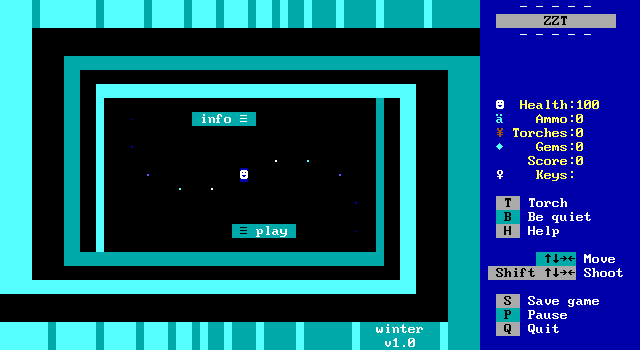
Even the main menu is a little artsy with its player-centered in a wavy pattern.

The story is simple enough, and very relatable to your average ZZTer in the late 90s. Class is boring, and you begin daydreaming. Except this dream begins to get a little too real.
The text file accompanying the game mentions that myth originally intended for the game to be darker, and I think it's to Winter's benefit that it didn't go for this. There's no feeling that anything is amiss in the dreamworld presented here with just the slightest hint that there could be something more at play here in the ending.

From the outside, this palace of the mind looks vaguely Arabian, but put in a cold, and well, wintry context. It's a grand palace, but one that's quite drab and uninviting. The frozen ground and blackened sky do make it a little less than friendly looking, scrapped dark story or no.

The palace serves as the main hub of the game. Winter is pleasantly non-linear, something that's always a plus when dealing with puzzles. It gives the player a chance to try something else if a puzzle isn't going their way.
Although, it's not quite as flexible as a more modern title might strive to be. Several of Winter's puzzles can render the game unwinnable, and as we'll see soon enough, once you enter an area outside the palace, you're there until that area is completed.
Winter is solidly designed, but do keep in mind the need to keep a handful of saves before making any sort of commitment, just in case.

As an extremely gentle introduction, the first thing the player gets to interact with has the appearance of a puzzle, but really isn't. There are three switches which can be toggled, but setting the first or third switch to "on" will turn the other of the two off.
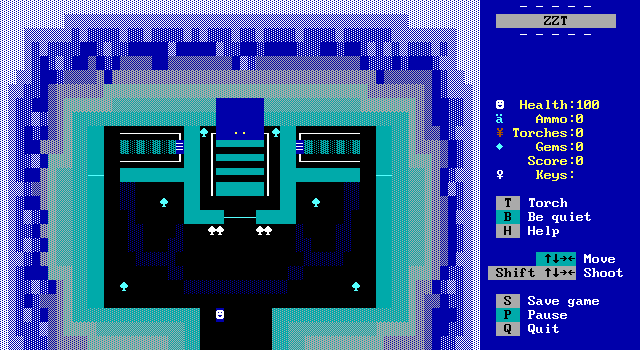
What the switches do isn't immediately obvious. I went north first and found nothing unusual, but that was because I had flipped the middle switch. The switches toggle barriers on other boards . The main way forward here may still be blocked, but the side staircases are open.
The spades are no more than decorative objects, with no description when touched. Myth is indeed committed to keeping the text to only what is necessary, with no need to clarify that these spades are statues or frozen plants or whatever.
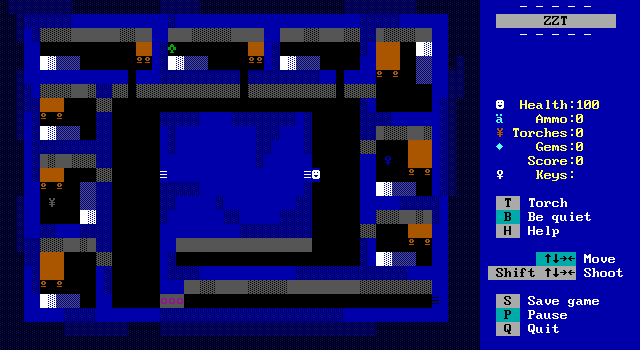
The upper floor consists of sleeping quarters with several small bedrooms. They each have a bed and desk, neither of which can be interacted with.

What can be interacted with, are the three objects scattered around the room. The key, the club, and the torch.
There's a brief moment of worry here when you see this mysterious text that it's just going to be something completely obtuse and not something whose purpose can be deduced playing the game normally. For now the symbols are unclear, but their meaning will be discovered soon enough.

Lastly, towards the bottom of the board are three locked purple doors. The use of several locked doors in a row like this (especially when they're all the same color, and especially when they're purple) indicates this to be a goal. Sure enough, the palace leads to three distinct areas which each hold a purple key.

For now there's nothing to be done up top, so a new direction was picked.

...not this one.

Since I didn't want to mess with the switches again, I just turned around and went west instead. This leads to a room that ends up capturing this game's spirit really well.
There's a vast empty space, but the player is blocked from moving past the four white markings.
Touching them plays some sounds and makes these streaks appear and fade away. In addition a symbol is displayed along the bottom.
Not surprisingly, these correspond to the symbols found in the bedrooms up above, but I didn't write any of them down so I was forced to turn around yet again.
I really want to give myth props for this puzzle design. The markings that fade in and out make this puzzle pop visually when a lesser game would have just had the four buttons light up and nothing more. Each button plays its own noise, and this could have been an audio puzzle, but by ultimately going with text, it works for those without a PC speaker, or for anybody hard of hearing. And it just looks so cool. I'm gushing about it without even getting to the part where I actually complete it.

Doomed to backtracking no matter what, I hit the switch just to see what would be to the right after all. Opening the path clears the force field of invisibles and opens a path outside.
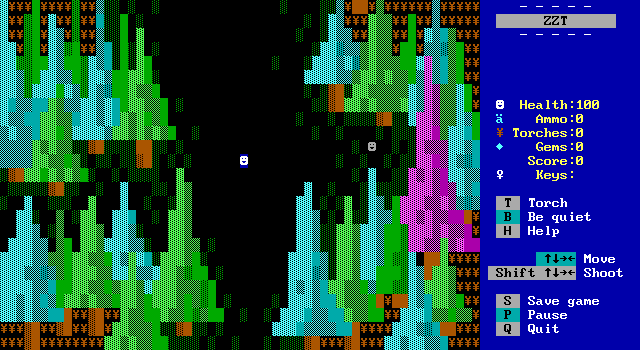
The passage warps the player to a new area, the "Underground Forest". Again myth nails the visuals here. Cyan for trees is an unusual choice and I would have believed that it was just meant to represent ice, but then there's also a purple one.
The board is barely using any STK-colors with only the breakables and normals of the tree trunks (plus the grassy fakes) not being producible in ZZT naturally. Yet the board looks like you'd imagine a pre-STK board to look. This board is to ZZT what Shovel Knight is to NES graphics.

Despite there being what appears to be a person. The lone object here simply gives up a blue key and stays silent. Person? Statue? Who knows?

Needless to say the forest is full of cyans and purples. Each board has an object which gives up a key.

This board in particular is extra colorful. Myth uses transporters to produce a simple layering effect so that the player gets to move "behind" some of the larger trees, but they serve a less obvious purpose as well. The transporters are arranged so that the player can't exit back from the top or bottom paths here, corralling them to the middle.

The middle loops back to the starting section.

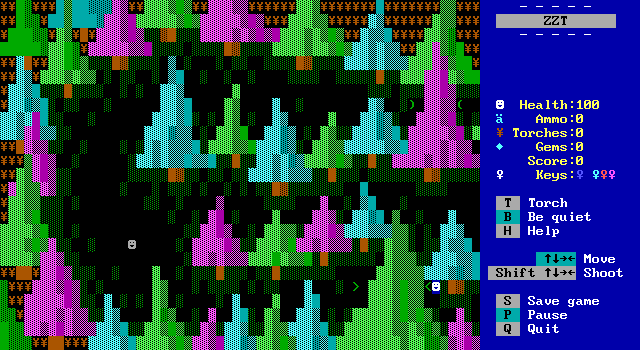
The surreal board connections mean the player always winds up here if they follow the north or south path. It took me a moment to realize that the one thing I hadn't done is travel west from the starting board of the forest.
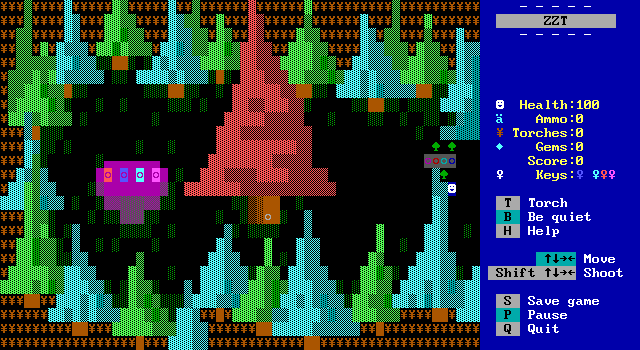
Which leads to this very large flashing tree! It's protected by four doors, but by this point I had already collected all the keys needed and was able to head on in.
If this was the puzzle for the forest, I'd be underwhelmed. I could have easily opted to go west from the very beginning and found this place right away.

There's a bit more to it than that though. Getting to the tree is the easy part. Getting inside it, takes a little more. There are four buttons here that have to be pressed in the proper order in order to open up the tree.
I'm not sure if I missed any clues to figure out the order without just guessing, but wrong answers don't do anything so it takes no time at all to guess the proper order: cyan, purple, red, blue.

Moments after inputting the code, the rest of the board vanishes, leaving only the tree frozen in an empty space, with a passage leading inside revealed.
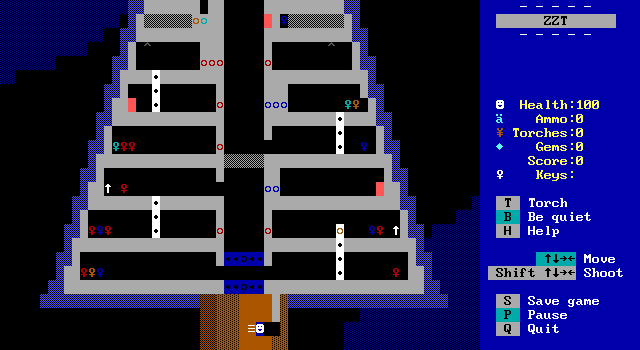
Now things really begin. Just by taking a look at the board it becomes clear that particular care needs to be taken to progress through the board, lest the player burn all their keys without finding replacements inside the opened chambers.

ZZT complicates this even further with its limitation of only letting the player hold a single key of each color. The tree is viewed on this board from the side and the player can't actually move upward in these chambers, only towards the end. This means the blue and yellow keys have to be picked up before picking up the red key.
If the player has a key of a color already, any additional keys of that color are essentially walls.

I was really impressed with this puzzle and how myth made it feel a bit more distinct. The side perspective, riding a little elevator up and down, and these levers to move gates make this sort of puzzle that's been done in ZZT plenty of times before stand out from previous iterations.

The last feature of the puzzle are these big red buttons which cause specific sections of breakable (looking) walls to fade away. I don't like the use of a solid character for them. It's clear they're something to interact with since they're behind some of the gates, but it just doesn't read as a button to me. A more traditional toggle of and might read a bit more nicely, but the solid version still contrasts enough from its surroundings that there's no mistaking them for an actual wall.

I got so close to just piecing my way through it on my first try. I'm going to blame this one on ZZT's awful doors where similar colors like red, purple, and yellow can be tough to distinguish from each other. Pro ZZTer tip: Use bright colored doors with the dark version of that color for the background to make them clear.
How did we manage telling them apart on CRTs using VGA connections?
The one good thing about messing up and getting that far was that I felt confident I could record myself making a second attempt, so spoilers for the tree puzzle if you want to watch how it's done.

After getting through, the reward is one of the purple keys stored in the tip of the tree with this excellent background of a starry sky with a cosmic swirl of blue.

Collecting the key causes the tree to blink out to nothingness leaving just a passage back to the castle behind. Myth really seems to like this transition, and I can say I'm a fan as well. It feels very final when it happens.

Taking advantage of ZZT"s passage behavior, the player gets dumped right where they started inside. Time to fiddle with some switches and try a new direction.

This time, the path up is opened. This is convenient since there's first a very important detour to open up the first purple door upstairs. Winter does have a risk that the player won't happen to go this way and wind up in a second area and get stuck because of a duplicate key.
For example, if the player entered the forest with a purple key in hand, they'd be unable to pick up the key in the tree, causing the passage to never become accessible.

While the forest didn't have any puzzles required to even access it, this next section involves some non-traditional slider moving.
Like the tree, the red walls here are also buttons. Pushing each one reduces the counter up top which will eventually open the way forward.

The twist here is that this object in the middle here can be touched to switch the direction the sliders point. Horizontal sliders become vertical and vice-versa.

It's very difficult to design a "good" slider puzzle, and I think myth falls short here. It's not bad, but it is very simple.


Compare this first corner I tackled at the start and when I was able to reach the button. It takes very little to get inside. The introduction of the gimmick actually makes these things way easier since you can just shove things out of the way pretty haphazardly compared to a traditional design.

Going through them, I'm also noticing that the amount of walls in the way is different between each corner. I imagine the walls are meant to make things tougher, but they do very little.

All in all, it's a weak puzzle, but I'd prefer something I can get through in a reasonable amount of time than something I spend all day on. This is no Machinations (thank goodness).
Hitting the fourth button causes all the sliders to disappear and lets the player proceed to the next area.
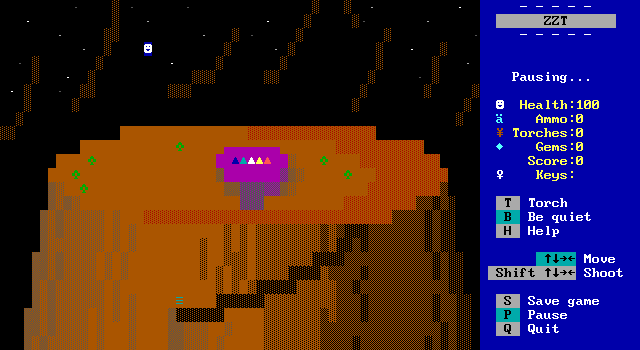
This leads to my personal favorite looking area, "Night Mesa". It's dark, and it's a mesa. I feel like this is the location with the most visual flair to it.
Even at the start, you'll note the player is in midair. Myth begins this segment by having an object push the player downwards, letting them fall from the starry sky on to the mesa's peak with several more mountains silhouetted in the background.

The obvious thing of note is this structure in the center. The first puzzle for the region? Not quite. There's nothing the player can do with them, but myth's "everything has a purpose" philosophy will give them meaning before the next key can be collected.

A download slope leads to a cave entrance within the mesa where the player does have to deal with an unfortunately tight torch limit.

Its path is fairly linear, but it's clear there's a bit more to it. This spot in particular is lined with half-block objects.

Most paths lead to dead ends, but things are simple enough that it doesn't take long to get to the exist. I just wish I wasn't burning my last torch already by the time I found it.




